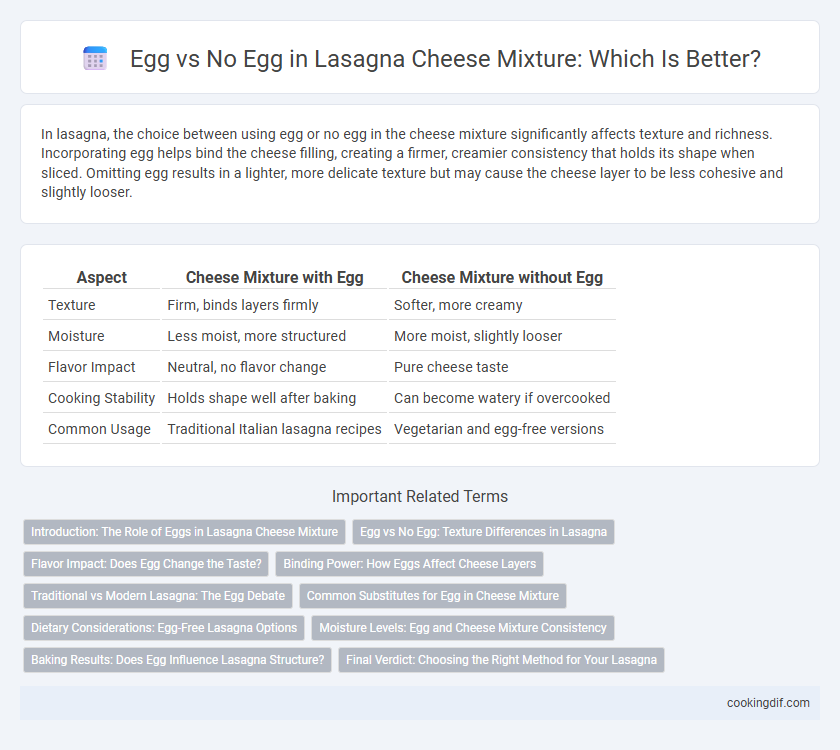In lasagna, the choice between using egg or no egg in the cheese mixture significantly affects texture and richness. Incorporating egg helps bind the cheese filling, creating a firmer, creamier consistency that holds its shape when sliced. Omitting egg results in a lighter, more delicate texture but may cause the cheese layer to be less cohesive and slightly looser.
Table of Comparison
| Aspect | Cheese Mixture with Egg | Cheese Mixture without Egg |
|---|---|---|
| Texture | Firm, binds layers firmly | Softer, more creamy |
| Moisture | Less moist, more structured | More moist, slightly looser |
| Flavor Impact | Neutral, no flavor change | Pure cheese taste |
| Cooking Stability | Holds shape well after baking | Can become watery if overcooked |
| Common Usage | Traditional Italian lasagna recipes | Vegetarian and egg-free versions |
Introduction: The Role of Eggs in Lasagna Cheese Mixture
Eggs in lasagna cheese mixtures act as a binding agent, enhancing the texture and stability of the dish by helping the cheese layer hold together during baking. Traditional recipes often incorporate eggs with ricotta or cottage cheese to create a creamy, firm consistency that prevents separate layers from sliding apart. Omission of eggs results in a softer, more fragile cheese filling, which may affect the lasagna's structural integrity but can be preferred for dietary restrictions or lighter texture.
Egg vs No Egg: Texture Differences in Lasagna
In lasagna, incorporating egg into the cheese mixture creates a firmer and more custard-like texture that holds its shape when sliced, enhancing overall structure. Without egg, the cheese filling remains softer and creamier, resulting in a more delicate and less rigid consistency. Choosing egg versus no egg impacts the balance between firmness and creaminess, influencing the final mouthfeel of the layered dish.
Flavor Impact: Does Egg Change the Taste?
Incorporating egg into the cheese mixture of lasagna subtly enriches the texture, making it creamier and more cohesive without drastically altering the primary flavor profile. The natural richness of the egg enhances the savory notes of ricotta and mozzarella, resulting in a slightly fuller taste experience. Omitting the egg maintains a lighter consistency, allowing the distinct flavors of the cheeses and herbs to shine more prominently.
Binding Power: How Eggs Affect Cheese Layers
Eggs enhance the binding power of cheese mixtures in lasagna by creating a firmer, more cohesive layer that holds its shape during baking. Without eggs, the cheese layer tends to be softer and more prone to spreading or leaking between pasta sheets, affecting the overall texture. Incorporating eggs improves structural integrity, resulting in cleaner cuts and a more defined lasagna composition.
Traditional vs Modern Lasagna: The Egg Debate
Traditional lasagna recipes often incorporate eggs in the cheese mixture to provide structure and a creamy texture, enhancing the binding of ricotta or other cheeses. Modern lasagna variations frequently omit eggs to reduce fat content and cater to dietary preferences, relying on thicker cheese blends or bechamel sauce for cohesiveness. The choice between egg and no egg in the cheese mixture significantly impacts the dish's texture and richness, reflecting evolving culinary trends and health considerations.
Common Substitutes for Egg in Cheese Mixture
Common substitutes for egg in lasagna cheese mixtures include ricotta cheese blended with cornstarch or flour to maintain firmness and prevent separation during baking. Silken tofu pureed with nutritional yeast can replicate the creamy texture and add protein without altering flavor. Another popular option is using blended cottage cheese combined with a small amount of plant-based milk to achieve a smooth consistency and binding effect.
Dietary Considerations: Egg-Free Lasagna Options
Egg-free lasagna recipes accommodate various dietary restrictions, including egg allergies and vegan preferences, by using alternative binding agents like tofu, mashed potatoes, or plant-based cheeses. These substitutes maintain the creamy texture of the cheese mixture while keeping the dish cholesterol-free and suitable for lactose-sensitive individuals when paired with dairy-free cheese. Preparing lasagna without eggs also reduces the overall calorie count and avoids potential cross-contamination in egg-free kitchens, making it a safer and inclusive option for diverse diners.
Moisture Levels: Egg and Cheese Mixture Consistency
In lasagna, incorporating egg in the cheese mixture helps bind ingredients, leading to a thicker, creamier consistency that reduces moisture separation during baking. Without egg, the cheese mixture tends to be looser and wetter, which can increase moisture levels and result in a potentially soggy texture. Controlling moisture balance through egg inclusion ensures even layering and optimal texture in the finished dish.
Baking Results: Does Egg Influence Lasagna Structure?
Incorporating egg into the cheese mixture enhances lasagna's structural integrity by acting as a binder, resulting in firmer slices that hold their shape well after baking. Without egg, the cheese mixture tends to be creamier but softer, which may cause the layers to be less defined and the lasagna to be more prone to collapse when served. Egg proteins coagulate during baking, improving the overall texture and stability of the lasagna layers.
Final Verdict: Choosing the Right Method for Your Lasagna
Using egg in the cheese mixture provides a richer texture and firmer consistency that helps the layers hold together during baking. Omitting egg results in a creamier, softer filling better suited for those seeking a lighter, more delicate lasagna slice. The final choice depends on personal preference and desired texture, with egg favoring structure and no egg enhancing creaminess.
egg vs no egg in cheese mixture Infographic

 cookingdif.com
cookingdif.com